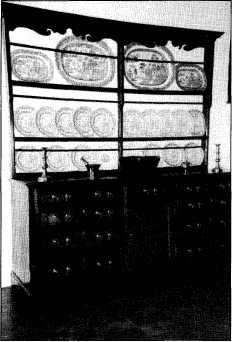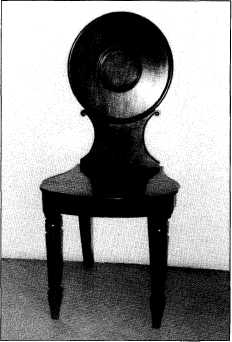| JOURNAL 1996 |
| North Craven Heritage Trust |
Eighteenth century Settle was a prosperous market town and very much a local centre of commerce. The old industries of woollen cloth making, knitting and leather making were complemented by luxury trades such as clockmaking and straw bonnet working. There were also cabinet makers at work, but little has been written about them, because much of their work has been unidentifiable. Now, however, it is possible to discover more about both the cabinet makers and their work.
We can start from the knowledge that the provincial clockmakers usually made only the movements of their clocks. The case had to be bought separately. It seems a fair assumption that many local buyers of Settle who made clocks might go to a local cabinetmaker to have a case made. Some allowance has to be made for the fact that after more than two centuries, some clocks will have been parted from their original cases and that some clocks would have been housed in non-local ones. Nevertheless, after examining and photographing a number of Settle made clocks, a pattern begins to emerge.
Many Settle clocks dating from the period 1765-1795 (dateable from the stylistic features of the dials as brass dials give way to painted dials) were indeed housed in cases with noticeable similarities, suggesting the work of one local cabinetmaker, or at least of one workshop. But who was he? Suspicion immediately centered on the Hallpike family, who in successive generations christened their sons Vincent.
From the Giggleswick parish registers, a detailed family tree can be built up. The first Vincent Hallpike appears in the Registers in 1710 when he married Agnes Routh. Other entries show that he had been born about 1684, probably outside the area. Indeed his name initially gave the Parish Clerk some difficulty, as he appears in the Registers under the various names of "Spikehall", "Pikehall" and "Pickauld" before the correct spelling was definitely adopted. The earlier variants sound almost Germanic!
It was the first Vincent's grandson, born in 1740 and married at Giggleswick in 1766, who developed the cabinet making business. When the Governors of Giggleswick School wanted a special box to hold their Royal Charter of 1553, it was this Vincent Hallpike who received their commission. This then is the man who is the most likely candidate to be the maker of fine local clock cases. How could this theory be proved?
Proof came in the form of the original clock purchased for Langcliffe Place Cotton Mill in 1785. The movement is by Thomas Hargraves and the case has the features which are found on many cases of this period. Although it is no longer in the area, the history of the Mill clock is well known to its owner. The original account books of William Clayton who built the Mill in 1783-4 are now deposited at Northallerton Record Office and give the full story.
On 5th March 1785, Clayton recorded that he paid Thomas Hargraves £2/5/0d for his new "time piece" and on 28th March 1785, Vincent Hallpike received £3/2/6d for the clock case and some laths. The clock remained at the Mill until its closure, when it was rescued by its present owner. The photographs illustrate the distinctive features which can be considered to be characteristic of the work of the Settle cabinetmakers.
The features worthy of note on locally made clock cases are that the bulk of the construction is in oak, but with mahogany trimmings. Most commonly these comprise crossbanding around the door to the case and hood, as well as around the base. The top of the door is attractively scalloped. Often there are fluted columns of mahogany to the hood and quarter columns to each side of the case. Sometimes a wide band of mahogany veneer is found above the top of the hood door.
The next step is to see whether these features can be found on other items of furniture which can then be attributed to Hallpike's workshop. We have to be much more wary here, since furniture does not have the benefit of containing a clock which is identified as Settle made. Nevertheless, there is still sufficient social stability around Settle to mean that there are local families whose ancestors lived here two centuries ago and who may have furniture which could have been made locally. Match such a history to the features which Hallpike used on his clock cases and an identification of Settle made furniture seems possible.
The Dresser illustrated is such a piece. It is still in Settle and features in an inventory of the current owner's great grandparents done in 1897 (when it already carried the willow pattern dinner service seen in the photograph). In 1897, it was in Long Preston. Before that, the family had lived in Rathmell, and had been there since the 18th century. The dresser has the mahogany crossbanding to the drawers and central door. The crossbanding in the top left and right corners of the central door has a small feature reminiscent of those seen on the bases of clock cases. The fluted mahogany quarter columns at each side of the dresser resemble those of the clock cases. The dresser's similarities of style and its known local pedigree strongly suggest that this is another Hallpike piece. It would be interesting to hear of other possible candidates.
Vincent Hallpike's son Vincent (born 1777) carried on the family business and is probably responsible for the pair of mahogany hall chairs which were purchased for Skipton Museum some years ago. These are stamped "V. Hallpike" underneath the front rail and are believed to have been made for the Settle Methodist Chapel built on Chapel Street in 1812. We can probably learn little from their style, which could have been produced anywhere in the country, but it alerts us to be on the lookout for other stamped pieces which could increase our knowledge of Settle made furniture.
The younger Vincent Hallpike seems to have been the last cabinetmaker of the family, but interestingly enough, his sister Agnes married Robert Harger, whose family continued as joiners in Settle into living memory.
Ian Roberts is grateful to the owners of the Langcliffe Place Mill Clock and the Settle Dresser for permission to photograph their property and to the Curator of Skipton Museum for allowing access to photograph the hall chairs there. An article in "Clocks" Magazine in March 1992 by John Robey first alerted him to the existence and significance of the Langcliffe Mill Clock.

J1996p10_19_files/tmp389-6.jpg
Detail of Langcliffe Place Mill Clock 1985
—shows mahogany crossbanding, quarter columns,
fluted pillar, door shape. Photo the author.

J1996p10_19_files/tmp389-7.jpg
A "Hallpike" Dresser, with the distinctive cross-banding and quarter pillars. Photo the author.

J1996p10_19_files/tmp389-8.jpg
Hall Chair c.1812. Stamped ' In the Craven Museum, Skipton.
'V. Hallpike". Photo the author.